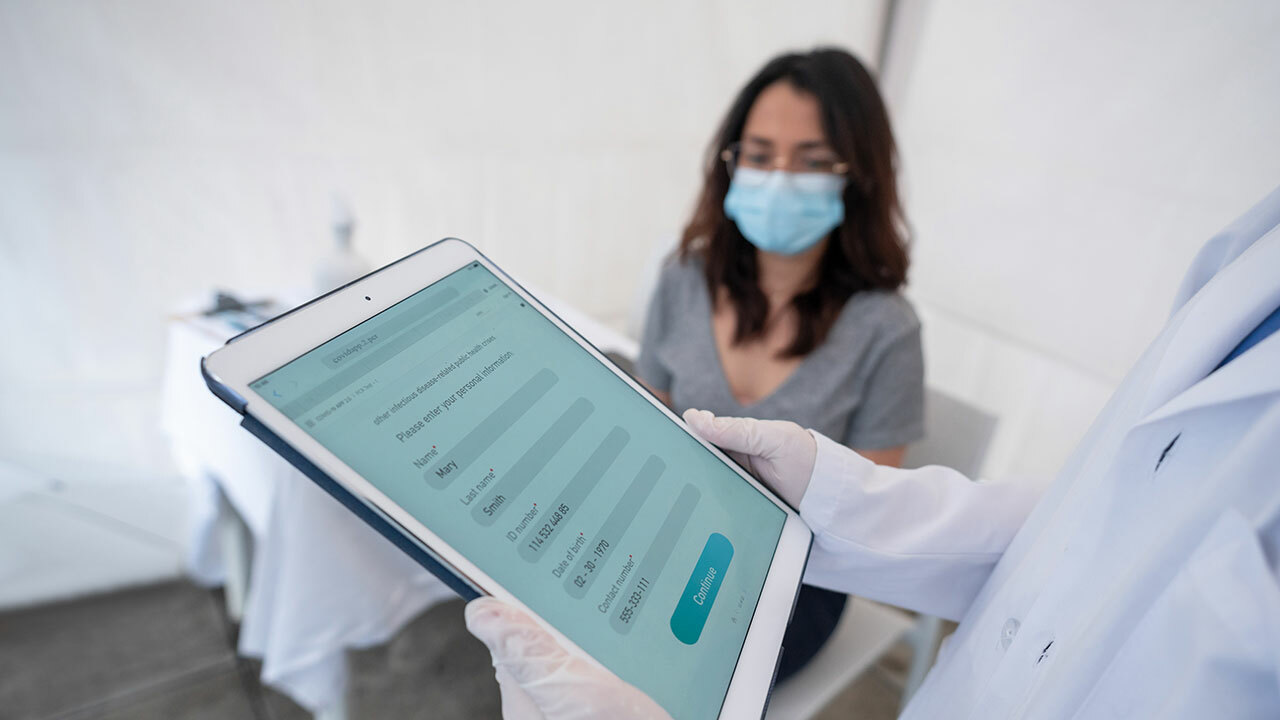A longtime leader in healthcare improvement, we’re developing new ways to revolutionize the industry.

Beyond COVID-19: Four Ways AI is Shaping the Future of Healthcare
This byline originally ran in Healthcare Innovation on May 18, 2021.
Well into the second year of the COVID-19 pandemic, the U.S. healthcare system remains under immense strain. The road to full recovery for our hospitals, health systems and healthcare staff is likely to be a long one, making it critically important to find ways we can ease pressure in the future.
Artificial intelligence (AI) technology like machine learning (ML) and natural language processing (NLP) shows great promise – with the ability to enable better collaboration and experiences for healthcare organizations, clinicians and their patients. And with more transferable health information, we can unlock incredible outcomes and process improvements for providers and patients.
Here are four of the biggest ways AI-enabled tech will drive healthcare forward long after the pandemic’s end.

1. Automating processes, improving efficiencies and enabling alternative care delivery models.
One of the most exciting areas driven by AI is remote patient monitoring (RPM), which is already leading to greater efficiencies and reduced costs for healthcare providers and is showing to improve clinical outcomes for patients. According to studies, RPM helps to:
- Reduce readmissions by 38 percent and emergency room visits by 25 percent.
- Improve patient satisfaction by 25 percent.
- Cut costs of care by 17 percent.
AI-powered RPM helps to keep people healthy in an automated fashion. Clinicians can stay close to their patients virtually and monitor certain conditions without the need for in-person visits. Data that’s captured delivers important clinical insights in real time, appropriate alerts and notifications are automatically triggered, and continuous contact is maintained between clinicians and patients under their care.
This technology proved especially useful during the pandemic, when in-person care was limited but patients still needed support from their healthcare providers. In fact, Premier members who had laid the groundwork for population health capabilities such as hospital at homebefore the pandemic reported caring for hundreds of patients on virtual acute floors and virtually monitoring upwards of 35,000 COVID-19 patients with less acute symptoms – thereby offering a safe and effective method to care for COVID-19 patients at home, freeing up hospital capacity and reducing avoidable emergency department (ED) visits.
RPM is also extremely useful to patients who live in rural or remote communities, or who lack transportation options, granting them access to care they may otherwise miss. To fully realize this benefit, patients must have a reliable rural or remote broadband connection.
By extending healthcare beyond the four walls of doctors’ offices, RPM efficiently brings care directly to patients, regardless of where they’re located; moves away from scheduling episodic visits and being reactive to acute illness to delivering more proactive care that enhances patients’ overall health and well-being; and paves the way to better disease management and prevention.
2. Predicting risks and suggesting interventions.
A second future-forward tech worth keeping an eye on is data- and ML-backed syndromic surveillance. ML uses algorithms to break down data, learn from it and then make a determination or prediction. Syndromic surveillance powered by ML is increasingly being used to solve a variety of healthcare industry problems, including providing accurate predictions of disease surge.
When integrated into a hospital’s or health system’s electronic health record (EHR), syndromic surveillance technologycan scan the EHR for key symptoms, such as for COVID-19 or other infectious diseases, then apply the data to predict which patients may have the disease and determine who’s likely to require hospitalization – before the admission occurs.
The data automation capabilities and real-time insights built into syndromic surveillance provide the intel needed to understand disease progression and predict disease risk to patients before it happens; track disease symptoms; and better manage public health by predicting hospital utilization, geographic surges and associated need for supplies and resources.
In short order, we anticipate that AI will inform providers of risks associated with social determinants of health and seamlessly enable coordination of care with community-based organizations to close social gaps.
3. Revealing patterns in disease, getting to a diagnosis quickly and advancing therapies sooner.
Another type of AI that’s poised to revolutionize the healthcare industry is NLP technology. NLP enables computers to understand, interpret and manipulate human language. When used in healthcare, NLP algorithms can search the 80 percent of valuable EHR content that’s unstructured, including clinicians’ free-flowing notes, pathology reports and other documents.
NLP accurately reads and interprets millions of pieces of content in record time, organizes the data and delivers insights to clinicians to help diagnose complicated conditions and better understand treatment protocols more quickly – leading to faster therapy and improved patient outcomes.
The tech is also useful in the life sciences arena, where it expedites the data extraction process associated with scientific studies and clinical trials. This is especially beneficial when study designers look for patients for studies in complex therapeutic areas, such as oncology, that require detailed phenotypic data, which cannot be found in structured data. However, they can be found in unstructured narrative data with the help of NLP.
4. Empowering patients to proactively manage their personal health.
The proliferation of wearable healthcare technology has enabled people to take far more control and ownership of their health and their lives. Devices like smart watches and fitness trackers collect real-time personal health data – including blood glucose, blood pressure and electrocardiograms – keeping people in the know on the data points that matter most to them and their well-being.
AI can convert this personal health data into clinically useful information, empowering patients to be more engaged with and proactive about their own health conditions. The data can be transmitted back to a hospital or physician’s office via a monitoring hub, helping providers understand their patients’ daily habits and provide more tailored, personalized care.
AI also aggregates personal health data with other data sources – medical records, family medical histories, DNA tests, social determinants of health – to create a more robust data set that offer keys to more effective prevention of illness and better treatment of individuals, as well as populations.
Unlocking AI’s Potential: The Road Ahead
All of these healthcare technology advancements are promising, but the biggest challenge we face now in AI success is liberating the mounds of data that are trapped in disparate EHRs and overcoming interoperability in health systems.
Health information sharing and usage among providers and researchers continues to be a major problem for the U.S. healthcare system. Premier has been working to solve this issue by advocating for policy change around health information technology (HIT), interoperability and data sharing.
We recently shared our healthcare policy solutions and recommendations in a letter to the Department of Health and Human Services Secretary Xavier Becerra. These include:
- Expand interoperability of EHR information systems through standards and open, affordable public application programming interfaces (APIs).
- Achieve access to data needed for research and performance improvement while ensuring privacy policies protect patients (i.e., substance use data, Medicare and Medicaid data, Health Insurance Portability and Accountability Act (HIPAA)).
- Pass legislation to require health plans to use electronic prior authorization (ePA).
- Advocate for privacy policies that do not overly impede provider use of patient information.
AI has great potential to improve healthcare delivery, and its full potential can best be realized when we have enabled access to data that up to now has been maintained in information silos. With appropriate protections for privacy and consent, we are confident AI will enable a new era of healthcare where data is foundational to improved efficiency, quality and patient/consumer responsiveness, as well as catalyzing clinical improvement.
The insights you need to stay ahead in healthcare: Subscribe to Premier’s Power Rankings newsletter and get our experts’ original content delivered to your inbox once a month.

